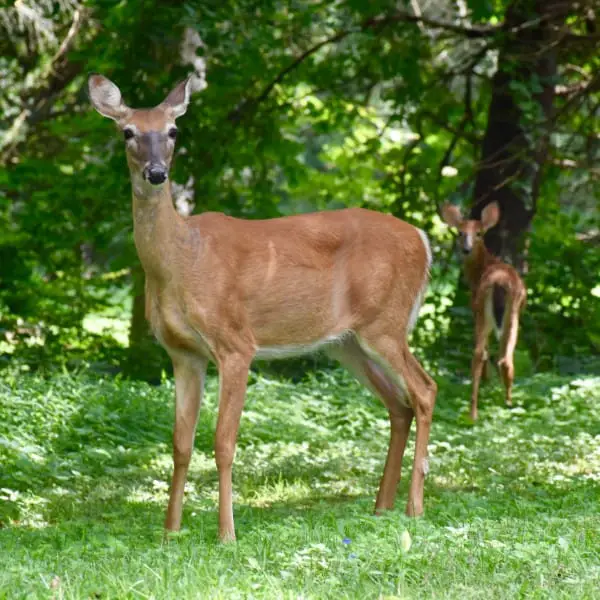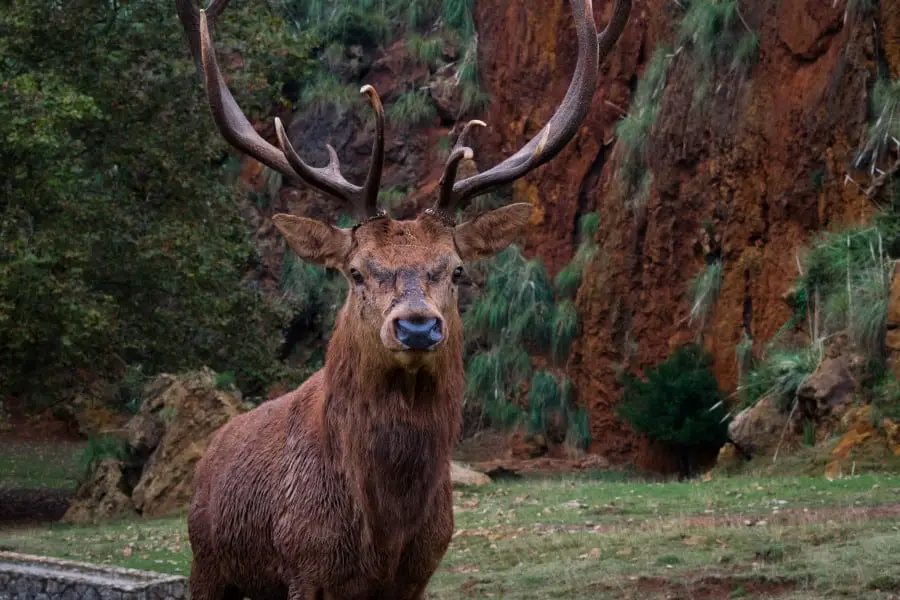You might be wondering what Deer do when they decide they need to sleep somewhere… where do deer sleep? So in this article, we’re going to discuss where Deer Sleep and their sleeping habits
But first, here’s the quick answer to get you some quick information, then we’ll dive into some details…
Where Do Deer Sleep? Deers sleep in places they regard as safe, with good availability of food resources. The places deer sleep vary according to times of the day, seasons, hunting pressure and birth stages. However, all these places will include easy escape exits, a clear view of threats, and camouflage.
It’s always perhaps a controversial discussion, when it comes to deer’s sleeping or if deer are actually asleep at all!
So let’s clear this point up first, deer can sleep with – or without – their eyes open. What’s interesting about their sleeping habits is their places of bedding.
Bedding is a behavioral activity where deer sleep as well as other activities such as relaxing, chewing and digesting food, grooming and even relaxing. A deer spends around 70 percent of its lifetime in its bedded area.
Of all the conditions, seasons, and other environmental factors that deers consider when choosing a location to sleep, they look for three essential things in any place they sleep, which are:-
- Coverage (camouflage)
- Clear area (of possible threats)
- Easy entrances and exits.

Where do deer sleep: Deer safe sleeping areas
Generally, deer sleep in places where they feel safe and secure. As well as locations that allow the deer to take advantage of thermals, winds, rain, sunlight, and water are the ideal places for deers to bed.
They also tend to bed in and sleep around or closer to places where they can easily find food and water resources.
Deer might sleep alone or in groups, they’re also creatures of habit. This is because when they find an ideal place to sleep, they tend to bed and sleep in the same place repeatedly for a period of time.
With that background set up, let’s move on to understanding where deer sleep depending on factors like times of the day, stage of birth, hunting pressure and seasons throughout the year.
Deer must be doing something right regarding their safety, around 100 years ago there were fewer than one million deer in North America. Today there are over thirty million!
You might also be interested in:
List of animals that hibernate
Time of day can change where Deer Sleep
Deer mostly sleep during the daylight hours. That also means they’re more active during the night or as “Nocturnal” creatures.
During the day deer can be found sleeping in fields, or areas containing bushes and foliage of around 5 feet tall or more where they are rarely visible.
Thick areas that would make a good bed of weed and grass are also an ideal place where deers sleep during the day.
They also prefer to sleep in woods at least 20 feet into the dense foliage and other deeper places. They mainly choose the places during the day to hide from the sight of predators and human hunters.
Deer may sometimes sleep in the open during daylight – in places like ridge tops or points. But open spaces are chosen only if they have good visibility in all (or most) directions.
They do not have good eyesight in the daylight but do have good eyesight at night. Mainly for making out the definition in shapes and general movement.
Better smell and hearing
But they have better senses of smell and hearing, so they focus on long-distance views and downwind odors to predict the threats that come their way.
This is because when sleeping, a deer still relies on its sense of smell, and hearing to warn of any potential threats.
When the night falls, deers seek dark places to sleep. Deer don’t sleep much during the night and so their ultimate purpose at night is self-preservation.
Even when they sleep at night, they sleep in such a way that helps them conserve energy. At night they typically use darkness, and silence, as a shield against predators.
At night they also sleep in hidden places. Some deer at night also find a suitable place around tall bushes and scrape the ground to make a comfortable bed for them to sleep or rest during the night.
And they repeatedly come to the same place each night to rest or other deer use them at night for resting for up to a couple of hours.
Where do deer sleep: Deer sleep position
Deer sleep mainly with their heads often moving occasionally to a variety of positions. Their eyes can be either open or closed but they can still doze.
Much like cats, deer can lay with their legs and arms tucked in and under, or on their side with legs curled – similar to how cats curl up – this is especially true of fawns
Where do deer sleep: Deer sleep cycle
During any sleeping cycle, they could speel (or doze) for anything from 30 seconds to a few minutes. Followed by a short duration of awake alertness. This cycle carries on for anything up to around 30-45 minutes. At which point the deer may rise to stretch and urinate or defecate. The cycle will then begin again. There are other animals that have different sleep patterns, and some don’t sleep at all!
Hunting pressure changes where deer sleep
Even though many European countries have since lost most of their large predators, they’re still available in some parts of Europe, and in the large wilderness and national park areas of the U.S and Canada.
Even with the absence of large predators, deer are still always cautious. As they have settled in the areas that border wilderness and human habitat for thousands of years. The areas between different environments, Also known as “the edge”
They have become familiar with human hunting practices. At night while the legal hour for hunting practices is over, deer make sure they sleep at places or locations where they are freer from human disturbances and predators.

When deer see a predator in the area they will hide, rest or sleep, they can alert other deer and other animals with a loud snorting sound.
This helps other deer to avoid bedding or sleeping in that location. So hunting pressure directly decides where a deer chooses to rest and sleep.
Newborn deer
Even newborn deer are kept in a safe place to sleep or bed by their mothers because of this hunting pressure. Within a few hours of birth, a fawn sleeps and stays in the bedded area for up to 95 percent of the time. Fawns are usually left to sleep under camouflage areas for added security.
What’s interesting about how deer decide where to sleep are their strategies? Yes! Deer do use certain strategies when deciding where to sleep or rest, especially when the area is prone to predators and hunting.
Deer find places where they can easily position themselves with a clear view. This includes tops and edges where they are less exposed.
But these places will, in turn, provide deer with the right view to see or sense threats. Sometimes they also prefer to sleep between large trees and fallen logs around leaf litter that crunches loudly.
The strategy behind these leaf litters is, of course, that they’ll be able to hear the sound of threats approaching and from which direction.
Deers also tend to sleep next to mast-producing hardwoods trees or shrubs, or in fields. The strategy behind this sleeping or bedding location is that that when a hunter enters the wood, they can easily hide or escape for their lives.
Deer awareness while sleeping
It might also be important to say no matter where deer sleep they‘re always in a constant state of awareness. Deer never fall into a deep sleep, their sleeping behavior is more like dozing.
They sleep typically for 30 seconds to a few minutes only at a time. To put it into a more clear understanding, being a famous prey animal means deer don’t get as much sleep as their predators!
Seasons throughout the year change where deer sleep
Of course, a deer’s sleeping locations do change according to seasons throughout the year. During the spring and summer, deer prefer locations where they can feel the fresh air and a cool breeze. Potentially with waterways nearby.
Also in summer, deer can also be found sleeping or relaxing in uninhabited woods or a cool bed of grass, weed and other tall bushes.
But when fall arrives and winter is approaching, deer hide deeper and deeper into thick woods or locations where they can get direct sunlight but protection from the harsh elements.
Educational resources
My First Book About Deer – a look at the lives of deer.
All about deer and where they live, an introduction to deer. True deer versus other deer Muntjac White-tailed deer Roe deer Moose Elk Fallow deer
Whitetail Savvy – New Research and Observations about Deer
Video resources
To close…
We hope this has been useful in understanding what deer do in terms of their sleeping habits, how they stay safe when resting and the kinds of places they look for.
Be sure to comment below with any input, and check out our other posts on all the kinds of questions you’ve thought of in the past concerning our wonderful wildlife.
This content has been checked and verified by a qualified veterinary practitioner. The article has been reviewed by our editorial board and has been approved for publication in accordance with our editorial policy.
